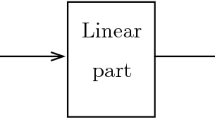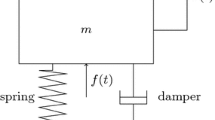Abstract
Fractional-order differential equations can describe the dynamics of robot formations and other high-order systems. These equations are useful models for such systems because of the flexibility afforded by including noninteger derivatives. A system’s fractional order may change in response to mechanical or operational damage, but the possibility of an order change is not typically considered in structural health monitoring or other system monitoring tools. Typically, the order is assumed to be an integer from the physics of the system, while behaviors are captured by parameters within the chosen model. In contrast, this work presents a procedure to identify the fractional order of a system’s dynamics across a variety of parameter changes; the inclusion of fractional orders allows order itself to measure dynamical shifts. This work presents the identification procedure, its mathematical foundations, and results from example systems representing two mobile robot formations. The fractional order changes in a manner consistent with the physical changes modeled by damage, suggesting that this procedure is widely applicable in health monitoring.
























Similar content being viewed by others
References
Goodwine, B.: Modeling a multi-robot system with fractional-order differential equations. In: Proceedings of the IEEE International Conference on Robotics and Automation, pp. 1763–1768 (2014)
Goodwine, B.: Fractional-order dynamics in a random, approximately scale-free network of agents. In: Proceedings of the IEEE Conference on Control, Automation, Robotics and Vision, pp. 1581–1586 (2014)
Leyden, K., Goodwine, B.: Using fractional-order differential equations for health monitoring of a system of cooperating robots. In: Proceedings of the IEEE International Conference on Robotics and Automation, pp. 366–371 (2016)
Heymans, N., Bauwens, J.: Fractal rheological models and fractional differential equations for viscoelastic behavior. Rheol. Acta 33, 210 (1994)
Mayes, J.: Reduction and approximation in large and infinite potential-driven flow networks. Ph.D. thesis, University of Notre Dame (2012)
Hartley, T.T., Lorenzo, C.F.: Fractional-order system identification based on continuous order-distributions. Signal Process. 83(11), 2287 (2003)
Das, S.: Functional Fractional Calculus. Springer, Berlin (2011)
Liu, D.Y., Laleg-Kirati, T.M., Gibaru, O., Perruquetti, W.: Identification of fractional order systems using modulating functions method. In: American Control Conference (ACC), 2013, pp. 1679–1684. IEEE (2013)
Narang, A., Shah, S.L., Chen, T.: Continuous-time model identification of fractional-order models with time delays. IET Control Theory Appl. 5(7), 900 (2011)
Zhou, S., Cao, J., Chen, Y.: Genetic algorithm-based identification of fractional-order systems. Entropy 15(5), 1624 (2013)
Oustaloup, A.: La dérivation non entière. Hermes, Paris (1995)
Ren, W., Beard, R.W., Atkins, E.M.: Information consensus in multivehicle cooperative control. IEEE Control Syst. Mag. 27, 71–82 (2007)
Fax, J.A., Murray, R.M.: Information flow and cooperative control of vehicle formations. IEEE Trans. Autom. Control 49(9), 1465 (2004)
Leonard, N., Fiorelli, E.: Virtual leaders, artificial potentials, and coordinated control of groups. In: Proceedings of the 40th IEEE Conference on Decision and Control, pp. 2968–2973 (2001)
Das, A.K., Fierro, R., Kumar, V., Ostrowski, J.P., Spletzer, J., Taylor, C.J.: A vision-based formation control framework. IEEE Trans. Robot. Autom. 18(5), 813 (2002)
Murray, R.M.: Recent research in cooperative control of multivehicle systems. J. Dyn. Syst. Meas. Control 129(5), 571 (2007)
Cao, Y., Yu, W., Ren, W., Chen, G.: An overview of recent progress in the study of distributed multi-agent coordination. IEEE Trans. Ind. Inform. 9(1), 427 (2013)
McMickell, M.B., Goodwine, B.: Reduction and non-linear controllability of symmetric distributed systems. Int. J. Control 76(18), 1809 (2003)
McMickell, M.B., Goodwine, B.: Motion planning for nonlinear symmetric distributed robotic formations. Int. J. Robot. Res. 26(10), 1025 (2007)
Goodwine, B., Antsaklis, P.J.: Multi-agent compositional stability exploiting system symmetries. Automatica 49, 3158–3166 (2013)
McMickell, M.B., Goodwine, B.: Reduction and non-linear controllability of symmetric distributed systems with drift. In: Proceedings of the IEEE International Conference on Robotics and Automation, pp. 3454–3460 (2002)
Karsai, G., Sztipanovits, J.: Model-integrated development of cyber-physical systems. In: Software Technologies for Embedded and Ubiquitous Systems, pp. 46–54 (2008)
Lee, E.A.: CPS foundations. In: Design Automation Conference (DAC), 2010 47th ACM/IEEE, pp. 737–742. IEEE (2010)
Derler, P., Lee, E.A., Vincentelli, A.S.: Modeling cyber-physical systems. Proc. IEEE 100(1), 13 (2012)
Reynders, E., Houbrechts, J., De Roeck, G.: Fully automated (operational) modal analysis. Mech. Syst. Signal Process. 29, 228 (2012)
Rainieri, C., Fabbrocino, G.: Development and validation of an automated operational modal analysis algorithm for vibration-based monitoring and tensile load estimation. Mech. Syst. Signal Process. 60, 512 (2015)
Chatzis, M.N., Chatzi, E.N.: A discontinuous unscented Kalman filter for non-smooth dynamic problems. Front. Built Environ. 3, 56 (2017)
Shirdel, A.H., Björk, K.M., Toivonen, H.T.: Identification of linear switching system with unknown dimensions. In: 47th Hawaii International Conference on System Sciences (HICSS), 2014, pp. 1344–1352. IEEE (2014)
Peeters, B., De Roeck, G.: Reference-based stochastic subspace identification for output-only modal analysis. Mech. Syst. Signal Process. 13(6), 855 (1999)
Juang, J.N., Pappa, R.S.: An eigensystem realization algorithm for modal parameter identification and model reduction. J. Guid. Control. Dyn. 8(5), 620 (1985)
Chatzi, E.N., Smyth, A.W.: The unscented Kalman filter and particle filter methods for nonlinear structural system identification with non-collocated heterogeneous sensing. Struct. Control Health Monit. 16(1), 99 (2009)
Jamaludin, I., Wahab, N., Khalid, N., Sahlan, S., Ibrahim, Z., Rahmat, M.F.: N4SID and MOESP subspace identification methods. In: IEEE 9th International Colloquium on Signal Processing and Its Applications (CSPA), 2013, pp. 140–145. IEEE (2013)
Chen, C.W., Juang, J.N., Lee, G.: Frequency domain state-space system identification. In: American Control Conference, 1993, pp. 3057–3061. IEEE (1993)
Oldham, K.B., Spanier, J.: The Fractional Calculus. Academic Press, New York (1974)
Baleanu, D., Machado, J.A.T., Luo, A.C.J. (eds.): Fractional Dynamics and Control. Springer, Berlin (2011)
Ortigueira, M.: An introduction to the fractional continuous-time linear systems: the 21st century systems. IEEE Circuits Syst. Mag. 8(3), 19 (2008)
Tenreiro Machado, J., Kiryakova, V., Mainardi, F.: Recent history of fractional calculus. Commun. Nonlinear Sci. Numer. Simul. 16(3), 1140 (2011)
Silva, M.F., Tenreiro Machado, J., Lopes, A.: Fractional order control of a hexapod robot. Nonlinear Dyn. 38(1–4), 417 (2004)
Delavari, H., Lanusse, P., Sabatier, J.: Fractional order controller design for a flexible link manipulator robot. Asian J. Control 15, 783 (2013)
Chen, Y., Moore, K.L.: Analytical stability bound for a class of delayed fractional-order dynamic systems. Nonlinear Dyn. 29(1–4), 191 (2002)
Zhao, C., Xue, D., Chen, Y.: A fractional order PID tuning algorithm for a class of fractional order plants. In: Proceedings of the IEEE International Conference on Mechatronics and Automation, pp. 216–221 (2005)
Monje, C.A., Vinagre, B.M., Feliu, V., Chen, Y.: Tuning and auto-tuning of fractional order controllers for industry applications. Control Eng. Pract. 16(7), 798 (2008)
Cao, Y., Ren, W.: Distributed formation control for fractional-order systems: dynamic interaction and absolute/relative damping. Syst. Control Lett. 59(34), 233 (2010)
Cao, Y., Li, Y., Ren, W., Chen, Y.Q.: Distributed coordination of networked fractional-order systems. IEEE Trans. Syst. Man Cybern. Part B Cybern. 40(2), 362 (2010)
Goodwine, B., Leyden, K.: Recent results in fractional-order modeling in multi-agent systems and linear friction welding. IFAC PapersOnLine 48(1), 380 (2015)
Ortigueira, M.D., Machado, J.T.: What is a fractional derivative? J. Comput. Phys. 293, 4 (2015)
Acknowledgements
The authors gratefully acknowledge many interesting and fruitful discussions with Fabio Semperlotti and Mihir Sen.
Author information
Authors and Affiliations
Corresponding author
Ethics declarations
Conflicts of interest
The authors declare that they have no conflict of interest.
Additional information
The partial support of the US National Science Foundation under the RI Grant No. IIS-1527393 is gratefully acknowledged.
Rights and permissions
About this article
Cite this article
Leyden, K., Goodwine, B. Fractional-order system identification for health monitoring. Nonlinear Dyn 92, 1317–1334 (2018). https://doi.org/10.1007/s11071-018-4128-y
Received:
Accepted:
Published:
Issue Date:
DOI: https://doi.org/10.1007/s11071-018-4128-y




